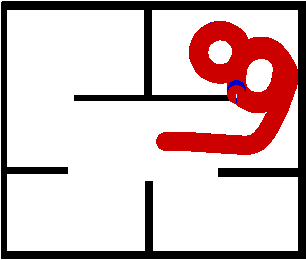int computeRotationalVelocity()
{
int currTV = State[38];
int currRV = State[39];
// always loop if possible
if(canTurn(1)) return 450; // try to full-loop left
if(canTurn(-1)) return -450; // try to full-loop right
// in tunnel or narrow. try to wall-follow
if(can90(1, currTV)) return 1; // predict hard left turn coming up
if(can90(-1, currTV)) return -1; // predict hard right turn coming up
if(currRV == 1) return 450; // was predicting hard left, do it
if(currRV == -1) return -450; // was predicting hard right, do it
// in a turn, see when to straighten out
int close = closestPt();
if(((close == 21) || (close == 29)) && (currRV < 430) && (currRV > -430))
return 0; // closest pt is to side and we've been
// turning at least 20 times in row, so
// go straight
// can't straighten yet, tick "counter"
if(currRV >= 430) return currRV - 1;
return currRV + 1;
}
bool canTurn(int curDir)
{
int sens1, sens2, sens3, sens4, sens5, sens6, sens7, sens8, sens9;
sens1 = State[17]; // front
sens9 = State[25]; // back
if (curDir < 0) // curDir < 0 means look right
{
sens2 = State[32];
sens3 = State[31];
sens4 = State[30];
sens5 = State[29];
sens6 = State[28];
sens7 = State[27];
sens8 = State[26];
}
else // curDir > 0 means look left
{
sens2 = State[18];
sens3 = State[19];
sens4 = State[20];
sens5 = State[21];
sens6 = State[22];
sens7 = State[23];
sens8 = State[24];
}
// Basically, test all sensors to see if their readings are >= the minimum
// value we think we need. "ok" returns true if the sensor is bigger than
// the value we're testing (also supposed to be true if the value is >255,
// because that's beyond our sensor range, but our code has a bug...)
if (ok(sens1, one) && ok(sens9, one) &&
ok(sens2, two) && ok(sens8, two) &&
ok(sens3, three) && ok(sens7, three) &&
ok(sens4, four) && ok(sens6, four) &&
ok(sens5, five)) return true;
return false;
// "one" through "five" are precomputed in the main function.
// If our sensors are >= these readings, then hopefully we have just
// just barely enough room to make a full loop. Performance is better the
// closer these values are to the minimum needed.
// Here are their values:
/*
radius = tv * 0.4 / PI; // radius of tightest circle we turn, in inches
// robRad == robot radius in inches
one = 0.5 * radius + robRad; // this is a guess on our part :)
two = 2 * radius * cos(0.375 * PI) + robRad; // actual trig for rest of
three = 2 * radius * cos(0.25 * PI) + robRad; // these values :)
four = 2 * radius * cos(0.125 * PI) + robRad;
five = 2 * radius + robRad;
*/
}
bool can90(int currDir, int currTV)
{
double sens1, sens2, sens3;
double predict = currTV * LOOKAHEAD_SECONDS; // amount of forward
// movement to predict, in
// inches
// look at front sensor and two sensors just to one side of front
sens1 = State[17];
if(currDir < 0) // curDir < 0 means look right
{
sens2 = State[32];
sens3 = State[31];
}
else // curDir < 0 means look left
{
sens2 = State[18];
sens3 = State[19];
}
// try to "adjust" sensor values to match what they'd look like after
// we moved forward a bit. This is not totally accurate but close for
// small predictions. PROBLEM: we don't check sensor just to OPPOSITE
// side of forward, so if we're about to scrape a wall on one side we
// may miss it-- this causes us to get in a lot of collisions
sens1 -= predict;
double opp = sens2 * sin(0.125 * PI); // don't try to figure this out :)
double adj = sens2 * cos(0.125 * PI) - predict;
sens2 = sqrt(opp * opp + adj * adj);
opp = sens3 * sin(0.25 * PI);
adj = sens2 * cos(0.25 * PI) - predict;
sens3 = sqrt(opp * opp + adj * adj);
// true means we think we can make the turn even after moving forward
if(ok(sens1, one) && ok(sens2, two) && ok(sens3, three)) return true;
return false;
}





